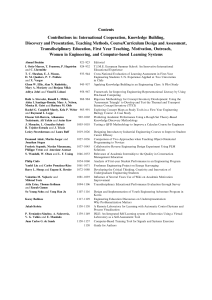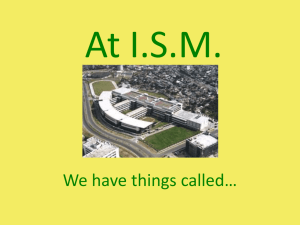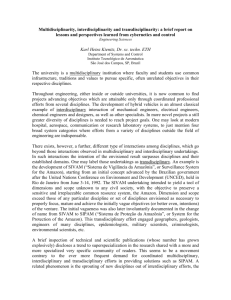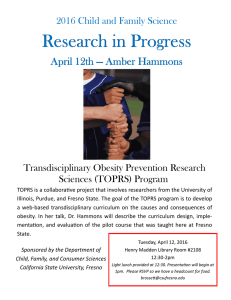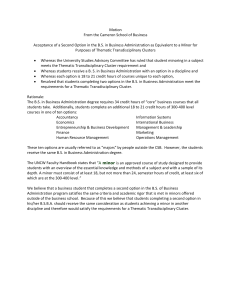Transitioning toward Transdisciplinary Learning in a Multidisciplinary Environment
advertisement
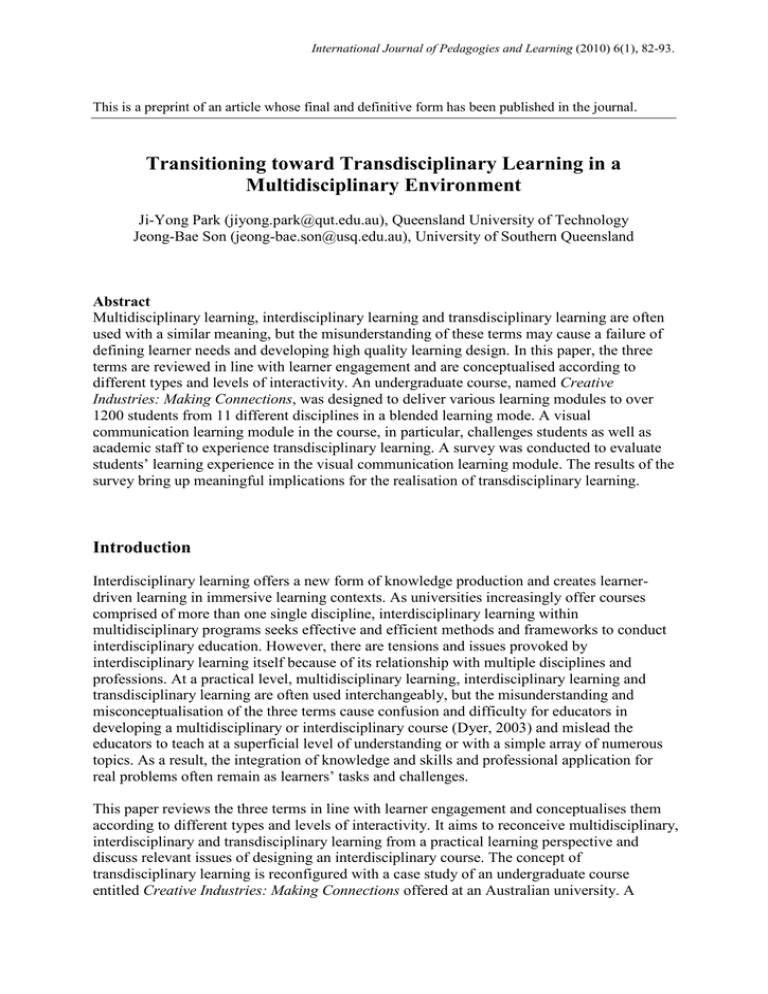
International Journal of Pedagogies and Learning (2010) 6(1), 82-93. This is a preprint of an article whose final and definitive form has been published in the journal. Transitioning toward Transdisciplinary Learning in a Multidisciplinary Environment Ji-Yong Park (jiyong.park@qut.edu.au), Queensland University of Technology Jeong-Bae Son (jeong-bae.son@usq.edu.au), University of Southern Queensland Abstract Multidisciplinary learning, interdisciplinary learning and transdisciplinary learning are often used with a similar meaning, but the misunderstanding of these terms may cause a failure of defining learner needs and developing high quality learning design. In this paper, the three terms are reviewed in line with learner engagement and are conceptualised according to different types and levels of interactivity. An undergraduate course, named Creative Industries: Making Connections, was designed to deliver various learning modules to over 1200 students from 11 different disciplines in a blended learning mode. A visual communication learning module in the course, in particular, challenges students as well as academic staff to experience transdisciplinary learning. A survey was conducted to evaluate students’ learning experience in the visual communication learning module. The results of the survey bring up meaningful implications for the realisation of transdisciplinary learning. Introduction Interdisciplinary learning offers a new form of knowledge production and creates learnerdriven learning in immersive learning contexts. As universities increasingly offer courses comprised of more than one single discipline, interdisciplinary learning within multidisciplinary programs seeks effective and efficient methods and frameworks to conduct interdisciplinary education. However, there are tensions and issues provoked by interdisciplinary learning itself because of its relationship with multiple disciplines and professions. At a practical level, multidisciplinary learning, interdisciplinary learning and transdisciplinary learning are often used interchangeably, but the misunderstanding and misconceptualisation of the three terms cause confusion and difficulty for educators in developing a multidisciplinary or interdisciplinary course (Dyer, 2003) and mislead the educators to teach at a superficial level of understanding or with a simple array of numerous topics. As a result, the integration of knowledge and skills and professional application for real problems often remain as learners’ tasks and challenges. This paper reviews the three terms in line with learner engagement and conceptualises them according to different types and levels of interactivity. It aims to reconceive multidisciplinary, interdisciplinary and transdisciplinary learning from a practical learning perspective and discuss relevant issues of designing an interdisciplinary course. The concept of transdisciplinary learning is reconfigured with a case study of an undergraduate course entitled Creative Industries: Making Connections offered at an Australian university. A International Journal of Pedagogies and Learning (2010) 6(1), 82-93. learning management system (LMS), Blackboard, was adapted to use for the course, which consisted of several learning modules such as collaboration, oral communication and visual communication. With the results of an online questionnaire, the case study mainly focuses on the delivery of a visual communication module, which challenges students as well as academic staff to experience transdisciplinary learning. In terms of learning design, interdisciplinary learning is applied to the multidisciplinary course in order to enhance the implementation of transdisciplinary learning. Multidisciplinary, Interdisciplinary and Transdisciplinary Learning Higher education faces many challenges with “a more recent blurring of disciplinary boundaries and genres” (O’Reilly, 2004, p. 724). Ertas, Maxwell, Rainey and Tanik (2003) argue, “Transdisciplinary thinking forces to one to think across, beyond, and through the academic disciplines to encompass all types of knowledge about an idea, issue, or subject” (p. 289). This implies that there is a need for the understanding and application of various disciplinary models. According to Garner (1995), the term ‘multidisciplinary’ refers to a combination of various disciplines as independent and separate components of learning, which allows students to work within discipline specific parameters and attain discipline specific goals. It is also mentioned when “researchers work in parallel or sequentially from disciplinary-specific bases to address common problems” (Rosenfield, 1992, p. 1351). In the case of team based learning in a multidisciplinary learning environment, students experience sharing communication more than collaborative problem solving. Therefore, effective communication between disciplines should be the key to the success of multidisciplinary learning, yet it is difficult to achieve without collaboration in learning. Interdisciplinary learning focuses on more collaboration and interactions between disciplines, so it requires “an organizational support infrastructure that promotes work interdependence, increases self-management, and increases responsibility on the part of team members for group performance and student outcomes” (Dyer, 2003, p. 186). Interdisciplinary learning requires a genuine interdisciplinary curriculum and teaching strategies based on students’ learning situations such as their attitudes, behavioural issues, communication and negotiation abilities (Crow & Pounder, 2000). From a collaborative research perspective, Rosenfield (1992) states that interdisciplinarity involves researchers who “work jointly but still from [a] disciplinary-specific basis to address a common problem” (p. 1351). Transdisciplinary learning, on the other hand, focuses on the outcomes of interdisciplinary learning, which come from students’ participation in learning and acquisition of knowledge and skills. Transdisciplinarity comprises “researchers working jointly using [a] shared conceptual framework that draws together concepts, theories, and approaches from the parent disciplines” (Rosenfield, 1992, p. 1351). It particularly emphasises students’ learning experience in sharing their skills and experiences (cross-training) and producing new knowledge. Mitchell (2005) argues, “True transdisciplinarity goes beyond simply drawing together concepts from the disciplines and that it creates new frameworks that break down (transgress) the traditional boundaries of the disciplines” (p. 332). Team members must be competent enough in their own disciplines and understand the language of all relevant International Journal of Pedagogies and Learning (2010) 6(1), 82-93. disciplines that enables them to contribute to the members’ quality research or learning and combine various perspectives to build up a new framework. Transdisciplinary Learning: A New Mode of Knowledge Production and Interactivity Multidisciplinary learning highlights learning of various topics from diverse disciplines; while interdisciplinary learning is based on a mixture of diverse disciplines to solve a problem. Transdisciplinary learning, taking interdisciplinary learning a step further, facilitates collaborative learning through a shared conceptual framework. Interdisciplinary and transdisciplinary collaborations enable teachers to form a new method of teaching and learning and assists students to gain tacit knowledge and skills. Traditionally, a discipline refers to a unique and discrete study area with its own history, method and content (Davies & Devlin, 2007). Unlike disciplinary-based learning, interdisciplinary learning and transdisciplinary learning offer multidimensional perspectives and methods through quality interactions between disciplines (Gibbons et al., 1994). In higher education contexts, “interdisciplinary education opens the way towards the integral education of the human being which necessarily transmits the quest for meaning” (Nicolescu, 1999, p. 7). Interdisciplinary learning “involves students in using more than one discipline in solving significant real world questions or problems” (Ibrahim, Fruchter & Sharif, 2006, p. 445) and, as a result, “students increase their capacity to make connections in their learning across the curriculum and between disciplines” (Seaton, 2002, cited in Ibrahim, Fruchter & Sharif, 2007). There is a significant difference between interdisciplinary learning and transdisciplinary learning in terms of knowledge production, which can be characterised by transdisciplinary problem solving through interdisciplinary collaboration. Conversely speaking, interdisciplinary collaboration will take transdisciplinary activities that “involve the integration of different skills in a framework of action” (Gibbons et al., 1994, p. 5). Thus, designing interdisciplinary learning entails the conceptualisation of transitioning from disciplinary-based learning to interdisciplinary learning to transdisciplinary learning. Interdisciplinary learning considers “the difference between qualitative and quantitative approaches or between analytical and interpretative approaches” whereas transdisciplinary learning “combines interdisciplinarity with a participatory approach” and generates “new knowledge and theory” (Tress, Tress & Fry, 2005, p. 17). The key characteristic of transdisciplinary learning is participatory collaboration in which various levels of participation can control the overall quality of a conceptual framework and learning outcomes. In a multidisciplinary learning context, transdisciplinary learning can be achieved by focusing on designing types of students’ participation and levels of students’ engagement in their collaboration and cooperation based on shared learning objectives and problems. International Journal of Pedagogies and Learning (2010) 6(1), 82-93. Table 1 Learning Modes and Interactivity Learning mode Subject Disciplinary Multidisciplinary Interdisciplinary Transdisciplinary Interactivity Student identity Topic driven Knowledge receiver Subjects driven Discipline to discipline driven Knowledge consumer Knowledge Learner collaboration driven collaborator Learner participation and new Knowledge producer knowledge creation driven Teacher identity Knowledge deliverer Knowledge facilitator Learning designer Interactive learning designer As shown in Table 1, five learning modes can be classified according to the types and levels of interactivity. In consideration of different types of interactivity, the concept of each learning mode is expected to be applied to different learning modules. A learning mode should be more than a selective learning method and requires a different way of designing learning experiences, concepts, approaches and assessments. The modes of subject, disciplinary and multidisciplinary learning mainly focus on the interactivity between students and content; whereas the modes of interdisciplinary and transdisciplinary learning focus on the interactivity between students and students. Interdisciplinary learning and transdisciplinary learning are also distinguished by the quality of students’ participatory experiences; transdisciplinary learning is expected to generate the highest level of learning interactivity through the design of students’ participatory framework toward problem solving. The levels of interactivity also affect student identity and teacher identity in the mode of transdisciplinary learning; teachers become interactive learning designers while students become knowledge producers. Interactive Learning to Enhance Interdisciplinarity and Transdisciplinarity Information and communication technology (ICT) offers the opportunity for students to learn independently and communicate efficiently. It can enhance the effectiveness of interdisciplinary and transdisciplinary learning. Transdisciplinary learning, in particular, can be well supported by ICT as educational features of ICT create new forms of interactions and communications (Park, 2008; Salmon, 2004). ICT-based learning enhances student-centred and regular face-to-face learning (Dziuban, Hartman & Moskal, 2004). It can generate creative and higher order thinking, reflective learning and collaboration (Broadfoot & Bennett, 2003) and improve problem-based learning through various types of synchronous and asynchronous communication (Dray & Siegel, 2004). The characteristics of ICT in education include various types of communication, high levels of interaction and flexible delivery. When these characteristics are well designed to reflect intended learning experiences and objectives, students’ active participation is highly anticipated and, as a result, transdisciplinary learning can be enriched and reinforced. Transdisciplinary learning and ICT seek the same objective in pedagogical contexts, which is to create a new form of knowledge through participatory collaboration. They have a thread of connection with constructivism. Citing Cooper (1993) and Wilson (1997), Ally (2004) notes, “Constructivist theorists claim that learners interpret information and the world according to International Journal of Pedagogies and Learning (2010) 6(1), 82-93. their personal reality and they learn by observation, processing, and interpretation, and then personalize the information into personal knowledge” (p. 7). Constructivist theory supports the effectiveness of the use of ICT in education, arguing that learning occurs through interaction with context and collaboration with peers. Learning activities should be cooperative and collaborative and provide opportunities for reflection and articulation (Oliver, 2001). In other words, constructivist learning in an ICT-based learning environment encourages the formation of learning communities through collaborative social negotiation and promotes learning outcomes through various interactions and communications as a learning strategy and process. Ally (2004) lists the following implications of constructivist theory for ICT-based learning: • Learning should be an active process that learners should be able to apply information in a practical situation; • Learners should construct their own knowledge rather than accepting knowledge given by the instructor; • Collaborative and cooperative learning should be encouraged to facilitate constructivist learning; • Learners should be given control of the learning process; • Learners should be given time and opportunity to reflect; • Learning should be made meaningful for learners and assignments and projects should be linked with meaningful activities to help learners personalise information; • Learning should be interactive to promote high level learning and social presence and help develop personal meaning. (pp. 18-20) Oliver (2001) asserts, “Constructivist online learning settings, by their very nature, are of a task-centred form” (p. 7). In comparison with constructivist theory in online learning, transdisciplinary learning requires designing students’ participatory learning experiences while considering levels of interactions. Ally (2004) insists that different levels of interactions will promote learning at different levels and proposes four levels of interaction in online learning based on Hirumi’s (2002) framework of interaction in online learning, which consists of three interactions: learner-self interaction, learner-human/learner-non-human interaction and learner-instruction interaction. Ally’s framework takes a step further from Hirumi’s framework and suggests interactions consisting of four levels on the basis of behaviourist, cognitivist and constructivist theories of learning. International Journal of Pedagogies and Learning (2010) 6(1), 82-93. Learner-interface interaction Learner-content interaction Learner-support interaction Learner-learner Learner-instructor Learner-expert Learner-context interaction Figure 1. Levels of interaction in online learning (Ally, 2004, p. 21) Ally’s four levels of interactions (Figure 1) are defined as follows: • Learner-interface interaction: The learner accesses and senses information, so the interface is where the learner uses the senses to register the information in sensory storage; • Learner-content interaction: The learner navigates through the content taking the form of pre-learning, learning and post-learning activities; • Learner-support interaction: While interacting with the content, learners look for learner-to-learner, learner-to-instructor and learner-to-expert support. This is a learning strategy to promote learner-context interaction; • Learner-context interaction: Learners personalise information and construct personal meaning from it. (pp. 21-22) Ally’s framework can be used to design online delivery of transdisciplinary learning, which promotes learners’ participatory and collaborative learning experience. Specifically, constructivist theory and online learning have a similar notion that effective learning can be achieved through students’ active participation in collaboration for problem solving and knowledge production within a shared conceptual framework. When transdisciplinary learning is designed with a form of blended learning with ICT, thus, there is a possibility that the effectiveness and efficiency of learning can be maximised. Learning Design in a Multidisciplinary Environment The faculty course in question, which over 1200 students from 11 different disciplines (including Acting and Technical Production, Communication Design, Creative Writing and Cultural Studies, Dance, Fashion, Film and Television, Journalism, Media and Communication, Music and Sound, Performance Studies, and Visual Arts) usually enrol in, International Journal of Pedagogies and Learning (2010) 6(1), 82-93. aims to foster students’ skills as collaborators and communicators in creative industries. It introduces students to a diversity of collaborative practices and supports them to develop fundamental visual and oral communication skills for effective participation in their studies and future profession within the creative industries. Its learning objectives focus on communication with media, namely oral communication, visual communication and interpersonal communication through a collaborative project. The ability to communicate using visual media, particularly, is an important skill for a professional career in the creative industries. Out of thirteen weeks, four weeks of lectures and lab classes are dedicated to cover relevant theories and practice of visual communication. The lab classes are arranged for students to give an opportunity to work on their practical understanding of how to apply the theories and build their skills with relevant software tools such as Adobe Photoshop. There is no impediment to the introduction of oral communication and collaboration skills to the students since these areas are generally perceived as generic skills. However, visual communication needs to be reinterpreted on the basis of the concept of interdisciplinarity to ensure that the learning content is related to each learning area and activities are designed in line with transdisciplinarity. The visual communication module requires individual students to create a digital image to be used for their collaborative project. In this context, transdisciplinary learning can be more effective than multidisciplinary learning because students’ learning process aims toward a collaborative outcome. Digital image creation, for example, delivers key aspects of the collaborative proposal concept to the target audience and encourages seeking peer review from other group members and peers. The visual communication module focuses on visual communication skills needed for students to solve problems collaboratively and reflect their experiences themselves rather than individual visual production activities. Although the tangible outcome of the visual communication module is one of digital image formats such as a PDF flyer or a digital wallpaper, the key objective of the module is to foster students’ ability of visual assessment and critiques of any visual form for better communication with others. Therefore, the content of the visual communication module, which is based on graphic design, has to be arranged and formatted to realise interdisciplinary learning. To do so, online and offline learning supports should be symmetrically organised for students’ collaborative and participatory interaction and cooperation. Table 2 presents the content design of the visual communication module. To deliver the content in a way of enhancing students’ engagement and participation, visual design theories are merged into technical skills and practical activities and the complex structure of the content is organised in a systematic and consistent manner. For learning materials, six different formats are adapted: lectures, tutorials, video lectures, video tutorials, workshop worksheets and interview video clips (image critiques with students on the street), which mainly focus on students’ acquisition of visual assessment and visual communication abilities through interdisciplinary communications. International Journal of Pedagogies and Learning (2010) 6(1), 82-93. Table 2 Content Design Weekly topic Lecture (1 hour) Video materials (lectures and tutorials) Student selfpractice Image critiques (street interview) Image critiques through street interview Workshop in Labs (2 hours) Week 5: Graphic design Summary of video content and study guideline Graffiti effect; pattern design Week 6: Layout design Summary of video content and study guideline Week 7: Colour scheme Summary of video content and study guideline Week 8: Digital image production Summary of video content and study guideline Visual design elements; introduction to Photoshop; image formats; image critiques Layout design; image manipulation 1; font and type / anti-aliasing; image critiques Image manipulation 2; colour theory and management; filters and effects; image critiques Wallpaper development process; image critiques Fog effects; snow effects Image critiques through street interview Image critique activities; PDF flyer design Pop art style; metal effect Image critiques through street interview Image critique activities; wallpaper design Wood effect; emboss effect Image critique activities; background image design Heavy metal CD cover design Along with the view that transdisciplinary learning is characterised by sharing a conceptual framework of collaboration to solve a given problem and create new knowledge, the one hour lecture allocated each week is used to guide students through the module and relevant instructions and to stimulate student engagement and encouragement. The lectures are mostly dedicated for presenting the content structure, study guide and relevant problems. For the delivery of the main learning content and skills, a video medium is chosen and each clip is 520 minutes long. Worksheets for self-study and tutorial activities in computer labs are also provided for actual communications and interactions with peers and tutors. To encourage students’ interdisciplinary communications, a range of communication channels are arranged both offline and online (see Table 3). Although the learning content and its delivery are designed for students’ active participation, there is a continuing demand for technical assistance to help students build their capacity to complete each assignment. In addition, a course email account is set up for individual inquiries. International Journal of Pedagogies and Learning (2010) 6(1), 82-93. Table 3 Communication Channels Offline communication Lab tutors Duty tutors Online communication Design discussion forums Visual Photoshop Formative feedback communication techniques Peer-assisted study scheme (PASS) tutors Email inquiries via course email account The module assignment involves a group task as well as an individual task since the images created by individuals are expected to be reused in their collaborative project. Students are asked to define the theme and format of digital images through group discussions and negotiations. They are also asked to share their development process with peers and other students through image critique activities in tutorials and image sharing in the discussion board on Blackboard. For the implementation of transdisciplinary learning, the content and learning support of the visual communication module attempt to reflect the students’ circumstances, previous learning, disciplinary differences and learning styles. In doing so, a systematic combination of the content and communication channels using multiple media is made to achieve the concept of transdisciplinary learning in the multidisciplinary learning environment. Survey Results and Discussions In order to evaluate students’ learning experiences in the visual communication module of the course, a questionnaire was developed and administered to two focused groups of students who could be categorised as active participants and less active participants. A total of 31 students were identified as active participants who engaged actively in the discussion board and frequently used online resources provided; while another 42 students were identified as less active participants who attended either lectures or tutorials somewhat regularly and preferred face-to-face learning. Their attendance of lectures and tutorials was not compulsory and did not affect their final marks of the course. The questionnaire consisted of four sections: Section 1 collected information on the types of students’ engagement with the module; Section 2 was about the students’ emotional responses to the module; Section 3 asked the students about their learning experiences in the module; and Section 4 gave the students space for their written feedback and suggestions. As shown in Table 4, the participants’ responses to the assessment of the course indicate that some were very excited whereas some others were very frustrated. These excitements and frustrations seem to reflect the participants’ attitudes toward the new assignments. On the other hand, over 70 percent of both groups of the respondents agreed that they experienced a sense of achievement from the module and about 60 percent of them agreed that the module was helpful. Overall, the transdisciplinary learning was found to be helpful for the students to connect the learning content, which was not directly related to their study areas, to their interests in a way that enhanced the sharing of a conceptual framework for learners’ participation and engagement. These results imply that the shared framework is the key to transdisciplinary learning, which needs to be developed by students rather than by assignments. Without the shared framework, students from many different disciplines may International Journal of Pedagogies and Learning (2010) 6(1), 82-93. not able to achieve transdisciplinary learning because of the diversity of their learning styles and preferred learning medium for communication and collaboration (cf. Peters, Jones & Peters, 2008). Table 4 Section 2 Results Q4. When you learnt what the nature of Assessment 2 was, how did you feel? Q5. While you were working on Assessment 2, how did you feel? Participants Very excited Excited Average Frustrated Very frustrated Total Participants Very excited Excited Average Frustrated Very frustrated Total Active 9 (29.03%) 9 (29.03%) 8 (25.81%) 2 (6.45%) 3 (9.68%) 31 (100.0%) Less active 3 (7.14%) 15 (35.71%) 13 (30.95%) 7 (16.67%) 4 (9.52%) 42 (100%) Active 5 (16.13%) 9 (29.03%) 6 (19.35%) 6 (19.35%) 5 (16.13%) 31 (100.0%) Less active 1 (2.38%) 12 (28.57%) 12 (28.57) 11 (26.19%) 6 (14.29%) 42 (100%) Q6. When you completed Assessment 2, how did you feel? Q7. Overall, how would you rate the visual communication learning? Participants A sense of high achievement A sense of some achievement Average Disappointed Very disappointed Active 10 (32.26%) Less active 3 (7.14%) Participants Very helpful 13 (41.94%) 27 (64.29%) Helpful 4 (12.903%) 2 (6.45%) 2 (6.45%) 10 (23.81%) 2 (4.76%) 0 (0%) Total 31 (100.0%) 42 (100%) Average Not very helpful Not helpful at all Total Active 6 (19.35%) Less active 5 (11.90%) 15 (48.39%) 18 (42.86%) 6 (19.35%) 1 (3.23%) 3 (9.68%) 10 (23.81%) 6 (14.29%) 3 (7.14%) 31 (100.0%) 42 (100%) With regard to the learning materials mentioned in Section 3 of the questionnaire (Tables 5 and 6), approximately 50 percent of the respondents in both groups agreed that lectures and tutorials were effective. Interestingly, 77 percent of the active participants chose that discussion board was the most effective while only 24 percent of the less active participants did (Q8). These responses indicate that the active participants learnt more through online communication than the less active participants. The less active participants showed a tendency to prefer face-to-face communication and individual learning materials by rating higher for tutorials and worksheets than the active participants. About 35 percent of both groups of the participants responded to Q9 that the module helped them communicate with students who were from another study area. It indicates that the visual communication learning delivery did not generate much interaction among disciplines. In their responses to Q10, however, more than 50 percent of both groups of the participants agreed that the module was either helpful or very helpful in relation to their study area. These results imply that the visual communication module delivery needs to be improved to encourage more active communications and interactions among students. It might be achieved through the design of more effective discussion forums and other materials such as video lectures and tutorials, which support and facilitate student-student and student-instructor communication and interaction. International Journal of Pedagogies and Learning (2010) 6(1), 82-93. Table 5 Section 3 Results: Question 8 Q8. What component(s) do you think were most effective in the visual communication learning module? (Multiple choice) Participants Lectures Tutorials Video lectures Video tutorials: Photoshop PASS tutorials Worksheets Image critiques Design Discussion Forum Content Index at del.icio.us Active 15 (48.39%) 16 (51.61%) 9 (29.03%) 10 (32.26%) 2 (6.45%) 2 (6.45%) 9 (29.03%) 24 (77.42%) 2 (6.45%) Less active 20(47.62%) 24 (57.14%) 13 (30.95%) 16 (38.10%) 7 (16.67%) 10 (23.81%) 19 (45.24%) 10 (23.81%) 6 (14.29%) Table 6 Section 3 Results: Questions 9 and 10 Q9. Do you think that the visual communication learning module helped you communicate with students who are from another study area? Q10. How would you rate learning about visual communication in relation to your course of study? Participants Strongly agree Agree Average Disagree Strongly disagree Total Participants Very useful Useful Average Not very useful Not useful at all Total Active 5 (16.13%) 7 (22.58%) 7 (22.58%) 5 (16.13%) 7 (23.58%) 31 (100.0%) Less active 2 (4.76%) 12 (28.57%) 17 (40.48%) 6 (14.29%) 5 (11.90%) 42 (100%) Active 8 (25.81%) 8 (25.81%) 9 (29.03%) 3 (9.68%) 3 (9.68%) 31 (100.0%) Less active 9 (21.43%) 14 (33.33%) 10 (23.81%) 5 (11.90%) 4 (9.52%) 42 (100%) Through Section 4 of the questionnaire, 24 active participants and 20 less active participants made positive or negative comments and suggestions. The active participants made more positive comments than the less active participants. The most positive comments were related to how the module was useful and helpful whereas the negative comments were mostly related to the lack of tutors’ technical skills in Photoshop and less links to their study areas. The less active participants proposed that the assignment needed to be more relevant to their study areas; while the active participants suggested that the online discussion forum activities should be marked and more collaboration-driven assignments would be useful for making connections between disciplines. These responses imply that there is a need for the module to be updated to the links between the learning design and students’ study areas and facilitate more participatory collaborative driven learning that matches with the concept of transdisciplinary learning. The results of the questionnaire provide several implications for the design of transdisciplinary learning. First, effective communication and interaction between disciplines are the requirements for the success of transdisciplinary learning. Students’ learning styles and preferred learning media could affect the quality of their interdisciplinary communication and interaction. Second, a shared conceptual framework needs to be developed through students’ interactive participation in learning. A collaborative assignment needs to include the development of the framework so that students can determine communication channels for their transdisciplinary learning themselves. Third, online and offline communication channels need to facilitate the learning process toward transdisciplinary learning. In this study, Blackboard was used to support students’ interdisciplinary communications, but the International Journal of Pedagogies and Learning (2010) 6(1), 82-93. communication channels were more individual focused than group focused. Collaborative communication channels are recommended for transdisciplinary learning. Finally, tutors’ collaboration with other tutors in engaging with students’ online communications and interactions is important for the enhancement of interdisciplinary and transdisciplinary learning. Conclusion This paper has reviewed multidisciplinary, interdisciplinary and transdisciplinary learning in terms of different types and levels of interactivity and discussed transdisciplinary learning as a new mode of knowledge production through participatory collaboration and its benefits in online learning. The results of the case study reported in this paper suggest that, in a multidisciplinary learning environment, the learning content and delivery including online communications and interactions should be designed to focus on learners’ participatory collaboration and their various learning styles and preferences. In other words, it is vital for transdisciplinary learning that a shared conceptual framework, which caters for learners’ different study areas, has to be created before designing learning sites, delivery formats and communication channels. The findings of the study indicate that the conceptual framework needs to be constructed with students’ active engagement and involvement through dynamic collaboration and cooperation between disciplines. Interactive learning can enhance transdisciplinarity if the conceptual framework and content delivery are systematically and strategically designed and integrated with student participation and engagement. References Ally, M. (2004). Foundations of educational theory for online learning. In Anderson, T., & Elloumi, F. (Eds.), Theory and practice of online learning (pp. 3-31). Canada: Athabasca University. Broadfoot, O., & Bennett, R. (2003). Design studios: Online? Apple University Consortium Academic and Developers Conference Proceedings 2003 (pp. 9-21). Wollongong: Apple University Consortium Academic and Developers. Crow, G., & Pounder, D. (2000). Interdisciplinary teacher teams: Context, design, and process. Education Administration Quarterly, 36(2), 216-254. Davies, M., & Devlin, M. (2007). Interdisciplinary higher education: Implications for teaching and learning. Centre for the Study of Higher Education, The University of Melbourne. Dray, S., & Siegel, D. (2004). Remote possibilities? International usability testing at a distance. ACM Interaction, 11(2), 10-17. Dyer J. A. (2003). Multidisciplinary, interdisciplinary, and transdisciplinary educational models and nursing education. Nursing Education Perspectives, 24(4), 186-188. Dziuban, C., Hartman, J., & Moskal, P. (2004). Blended learning. EDUCAUSE Center for Applied Research Bulletin. Ertas, A., Maxwell, T., Rainey, V. P., & Tanik, M. M (2003). Transformation of higher education: The transdisciplinary approach in engineering. IEEE Transactions on Education, 46(2), 289-295. Garner, H. (1995). Teamwork models and experience in education. Boston: Allyn and Bacon. International Journal of Pedagogies and Learning (2010) 6(1), 82-93. Gibbons, M., Limoges, C., Nowotny, H., Schwartzman, S., Scott, P., & Trow, M. (1994). The dynamics of science and research in contemporary societies. London: SAGE. Hirumi, A. (2002). A framework for analyzing, designing and sequencing planned elearning interactions. Quarterly Review of Distance Education, 3(2), 141-160. Ibrahim, R. Fruchter, R., & Sharif, R. (2006). Changing trends in architectural design education. In J. Al-Qawasmi & G.V. de Velasco (Eds.), Defining an innovative architectural-construction integration design studio for sustainable global practice (pp. 441 - 454). Jordan: Centre for the Study of Architecture in the Arab Region. Ibrahim, R. Fruchter, R., & Sharif, R. (2007). Framework for a cross-border transdisciplinary design studio education. Archnet-IJAR, 1(3), 88-100. Mitchell, P, H. (2005). What's in a name? Multidisciplinary, interdisciplinary, and transdisciplinary. Journal of Professional Nursing, 21(6), 332-334. Nicolescu, B. (1999). The transdisciplinary evolution of learning. UNESCO publication collection. Retrieved September 9, 2009, from http://www.unesco.org/education/educprog/lwf/dl/nicolescu_f.pdf Oliver, R. (2001). Developing e-learning environments that support knowledge construction in higher education. In Stoney, S., & Burn, J. (Eds), Working for excellence in the economy (pp. 407-416). Perth: We-B Research Centre, Edith Cowan University. O’Reilly, M. (2004, December). Educational design as transdisciplinary partnership: Supporting assessment design for online. In R. Atkinson, C. McBeath, D. Jonas-Dwyer & R. Phillips (Eds.), Beyond the comfort zone: Proceedings of the 21st ASCILITE Conference (pp. 724-733). Perth, Australia. Retrieved September 9, 2009, from http://www.ascilite.org.au/conferences/perth04/procs/oreilly.html Park, J. Y. (2008). Online learning of visual design course: Framework for the interactive learning. The International Journal of Learning, 14(12), 13-21. Peters, D., Jones, G., & Peters, J. (2008). Preferred ‘learning styles’ in students studying sports-related programmes in higher education in the United Kingdom. Studies in Higher Education, 33(2), 155-166. Rosenfield, P. L. (1992). The potential of transdisciplinary research for sustaining and extending linkages between the health and social sciences. Social Science & Medicine, 35(11), 1343-1357. Salmon, G. (2004). E-moderating: The key to teaching and learning online (2nd Edition). New York: Routledge Falmer. Tress, B., Tress, G., & Fry, G. (2005). Defining concepts and process of knowledge production in integrative research. Heidelber: Springer.
